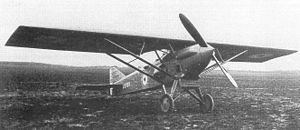Top speed 242 km/h Length 9.44 m Manufacturer Avions Michel Wibault | Wingspan 13 m First flight May 1926 | |
 | ||
The Wibault 12 Sirocco or Wib 12 Sirocco was a two seat, parasol wing fighter aircraft designed and built in France in the 1920s. Three fighter prototypes were completed, one for the RAF, together two Army co-operation variants. There was no series production.
Contents
Design
The Wib 12 Sirocco, a single engine, two seat, parasol wing fighter was a structurally much revised development of the similarly configured Wib 8 Simoun, following it through the Avions Marcel Wibault works with less than a month between their maiden flights. They were externally very similar but the more refined structure of the Wib 12 made it both stronger and 12% lighter than its predecessor. One major change was the replacement of the Wib 8's box spars with ones of I-section.
The general design followed that of Wibault's family of single- and two-seat fighters, the Wib 3, Wib 7, Wib 8 and Wib 9 but in external detail was closest to the Wib 8. It was an all-metal aircraft, the structure mostly Duralumin and covered with narrow aluminium strips applied longitudinally. The parasol wing was straight edged and of constant chord, braced to the lower fuselage with a pair of parallel struts on each side which met the wing at about mid-span. The Wib 12 had a new pair of jury struts from the main wing struts to the wing underside for strengthening. There were cabane struts over the fuselage and a trailing edge cut-out in the wing over the pilot's cockpit to enhance his visibility. A pair of synchronised 7.7 mm (0.303 in) Vickers machine guns fixed to the fuselage fired forwards through the propeller arc; in addition the rear cockpit was fitted with a pair of Lewis guns of the same calibre on a Scarff ring. A braced tailplane was mounted towards the top of the fuselage, together with an angular fin and rudder.
The Wib 12's engine, the same 500 hp (373 kW) water-cooled V-12 Hispano-Suiza 12Hb type as used by the Wib 8, was totally enclosed and drove a two blade propeller. It was cooled by a retractable, half-cylindrical radiator on the fuselage underside at the back of the engine. Behind the engine the fuselage was flat sided. The fighter had a fixed conventional undercarriage with mainwheels on a split axle attached to the fuselage underside, supported by a pair of V-struts; there was a small tailskid.
The Wib 12 and the Wib 121 (the first and second prototypes) were both flown for the first time in May 1926. The latter was about 8% faster in a climb to 4,000 m (13,125 ft) than the heavier Wib 8. The third aircraft, the Wib 122 was built for Vickers aircraft, with whom Wibault shared patents and collaborative designs. They fitted it with a 410 kW (550 hp) W-12 Napier Lion XI engine and knew it as the Vickers Type 127. To avoid the central bank of cylinders the Vickers guns were moved from the fuselage top to the sides. Its test programme was interrupted by continual engine overheating problems.
When the Service Technique de l'Aéronautique (S.T.Aé, Technical Department of Aeronautics) cancelled the two seat fight specification in 1926, further development by Wibault also ended; though the Wib 121 went on a sales demonstration in Turkey in 1928, no orders were gained. Instead, the company tried to develop the design into a two seat Army cooperation reconnaissance aircraft. The Wib 124 had its armament modified, having no wing guns and only one fuselage mounted synchronised Vickers machine gun, but with an added ventral Lewis gun. The Wib 125 had the same armament but was powered by a Renault 12 Jc 500 hp (373 kW) water-cooled V-12 engine. Again, no orders resulted.
Variants
C=Chasseur (fighter); A=Army; 2=two-seater. One of each only.
Specifications (Wib 121 C.2)
Data from Green & Swanborough p.596-7
General characteristics
Performance
Armament
